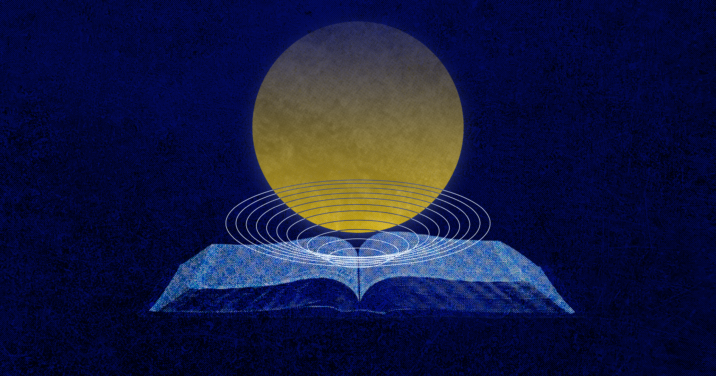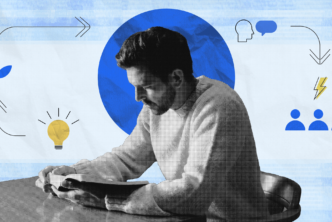A Bible concordance is simply a reference tool in which words from a particular translation of Scripture are arranged alphabetically in a kind of index—often accompanied by words from the immediate context of each use. Scripture references are listed in canonical order for each word, and entries sometimes include part of each sentence where the word occurs.
Here, for example, is a concordance generated by the Logos Bible Study App from the Christian Standard Bible New Testament:

Bible concordances are helpful for everyone interested in the Bible, from scholars to students to Bible study enthusiasts. Concordances can help you mine Scripture for more profound insights you otherwise would not have access to. Many Christians find that using a concordance transforms their Bible study. It did for me.
Keep reading to learn the many ways Bible concordances can aid your study of the Bible—and discover the top seven Bible concordances available today. Or skip to the sections below that interest you most:
- Why use a Bible concordance?
- What is a concordance in a Bible?
- Types of Bible concordances
- The history of Bible concordances
- Strong’s Exhaustive Concordance
- What’s included in a Bible concordance entry?
- How to use a Bible concordance
- What’s the difference between a Bible dictionary and a concordance?
- Top 7 Bible concordances
- How to choose a Bible concordance
- Benefits of digital Bible concordances
- Unique Bible concordances
Why use a Bible concordance?
Using a concordance can enhance your study of the Bible by giving you basic access to the Hebrew and Greek from which the Bible was translated.
For example, if I look up the word “blessed” in a concordance, I find its definition in Hebrew (in the Old Testament) or Greek (in the New Testament), along with a list of every verse in the Bible that uses the word. A concordance makes it easy to find specific words and phrases that I can remember but can’t find. It helps me find parallels in meaning between Scripture passages. I can even use a concordance to find themes within a biblical book.
But there’s practical and personal benefits to using a concordance, too. Here are three:
1. A Bible concordance helps bridge language study and biblical interpretation.
Bible concordances can help you do in-depth word studies, even if you don’t know Hebrew or Greek. They can help you locate every place a word occurs in the Bible, even when you can’t remember the chapter or verse. Concordances define particular words, help you find translations of the original language word into English, and show which verses contain certain words (and how many times). Using one makes me feel—smart.
2. They can deepen personal reflection and meditation.
Most people wouldn’t say that personal reflection and meditation are top reasons to use concordances; yet, I find them to be some of the best aids in my devotional time with God. An in-depth study of just one Hebrew word can take me down another path that opens up a familiar passage in a whole new way, drawing me closer to God.
3. They’re invaluable for preparing sound sermons.
Concordances are also powerful resources for sermon prep. Preachers who lean on concordances are more confident that their sermons are thorough, contextually accurate, and rooted in biblical truth.
Regardless of your end goal, using a concordance alongside Bible study will give you a deeper level of understanding of God’s Word and uncover meaning you might have otherwise missed. Over time you’ll realize you have a more comprehensive understanding of Scripture and are better equipped to apply it to your life appropriately.
What is a concordance in a Bible?
Most Bible publishers include a concise concordance in the back of at least some of their Bible editions. Some editions even boast extensive concordances. Separate, more exhaustive concordances are helpful for more in-depth study.
Typically, a concordance in a Bible lists words alphabetically; and under the word, a short phrase pulled from the verse, often with the word in the verse bolded with only the letter. For example, let’s say I was sharing with someone about how believers are sealed with the Holy Spirit as a guarantee—but I can’t quite remember where that verse is in the Bible. I simply flip to the back of my New King James Version (NKJV) Bible, find “guarantee,” and look for the few words close to the verse I’m searching for. I find three options:

Often I see the one I’m looking for straightaway. But if I’m not sure, I can head to each verse until I find the exact one I’m looking for.
It’s true that I could look those words up on my smartphone and almost certainly find the verse I want. But I’ve found that when leading Bible studies or talking with someone about a concept in the Bible, flipping to the concordance in my Bible and showing how to find a word or topic in Scripture equips others to know how they can do the same on their own.
Types of Bible concordances
Though incredibly helpful for deepening Bible study, the concordances included in Bibles are pretty basic. However, stand-alone concordances are usually exhaustive, and understanding how back-of-the-Bible concordances differ from exhaustive ones will help you know which will aid you best in your personal study of God’s Word.
Exhaustive
Exhaustive concordances are beefy. They include every word in the Bible (minus words like a, the, and but) in alphabetical order, along with the book, chapter, and verse reference for every occurrence. But they also include Hebrew–Aramaic and Greek dictionaries (or “lexicons”). The most popular is Strong’s Exhaustive Concordance, a concordance of the King James Version that was first published in 1890. Its numbering system remains the best known standard for English speakers wishing to identify Greek and Hebrew words (more on this below). Another example is the New American Standard Exhaustive Concordance, Updated Edition: Hebrew–Aramaic and Greek Dictionaries. It uses Strong’s numbering system and is based primarily on Brown, Driver, and Briggs English Lexicon of the Old Testament and Bauer’s Greek Lexicon.
Abridged
An abridged concordance displays only essential words along with representative Scripture references.
Topical
Topical concordances classify passages of Scripture by subject rather than by the use of specific words. The Holman Concise Topical Concordance, for example, contains more than six thousand such topical headings listed in alphabetical order accompanied by more than a hundred thousand Scripture references.
Complete
Complete Bible concordances contain primary words in the Bible but not conjunctions and prepositions, as would an exhaustive concordances.
Concise
These concordances list selective words. (They’re the kind of concordance found at the back of a Bible.)
Analytical
Analytical concordances like An Analytical Concordance to the Holy Scriptures arrange the entire Bible topically. They are still a concordance of words, but Scripture references are ordered by subject and grouped under headings and subheadings that help readers see the internal connection of topics within Scripture.
The history of Bible concordances
Jeffrey E. Miller writes:
The first concordance was developed by Dominican monks in Paris between AD 1230 and 1235—shortly after chapter divisions were incorporated into the Latin Bible (modern verse divisions were introduced AD 1551)—to assist priests in their sermon preparation. Because a concordance’s purpose is to provide the location of a word in the Bible, such a tool was unthinkable prior to universally-recognized Bible divisions.1
The King James Version (KJV) of the Bible was published in 1611, and the first concordance developed for that version came in 1879: Robert Young’s Analytical Concordance of the Bible—still used widely today. Though Young’s was a huge accomplishment (it took over forty years to finish!), when Strong’s Exhaustive Concordance was published in 1890, it quickly became a classic because of its unique numbering system that dramatically changed Bible word study.
Strong’s Exhaustive Concordance
Strong’s Exhaustive Concordance is, as its name implies, an exhaustive (meaning “thorough” or “complete”) concordance specific to the King James Version of the Bible. It’s one of the most comprehensive concordances, and for many preachers and readers of Scripture, it’s their first stop when studying any word in the Bible. The first half of this massive word index lists every word in the Bible alphabetically in English. The second half lists every word alphabetically in the Bible’s original languages—Hebrew and Greek.
First published by Dr. James Strong in 1890, most print copies of Strong’s are beefy—some weigh over five pounds! Strong’s will tell you much of what you need to know about a word and related words, as well as where to find them in the Bible.
For example, if I wanted to study the concept of being “blessed,” I’d want to find every verse that uses the word. But I’d also want to compare those verses against others that use related words—and even opposite words, like “curse.” And I’d find all that in Strong’s.
It was Strong who first assigned every single word in the Bible a reference number corresponding to its original language word (Hebrew, Aramaic, or Greek). For example, the number assigned to one use of “blessed” in Hebrew is 1288, and one in Greek is 3107. Those numbers are still used in other Bible study resources today. Searching those numbers will reveal all the different verses that use that word.
Strong’s is a historic and celebrated concordance that powerfully influenced the genre. However, it does have a few errors and there are better, more accurate concordances available today.
What’s included in a Bible concordance entry?
Most concordances will include the subject (often bolded), all the word forms, a list of occurrences according to the book title, chapter and verse location, a few words of context, and often the Strong’s reference number that corresponds with a Hebrew or Greek dictionary entry.
How to use a Bible concordance
Using a concordance is an easy, three-step process:
- Choose a word.
- Look up that word (words are listed alphabetically, so that’s easy), and scan the entry for the verse and reference number you’re looking for.
- Head to the dictionary to look up the reference number. (Old Testament words will be in the Hebrew–Aramaic dictionary, and New Testament words in the Greek.) Entries are listed numerically, not alphabetically, so don’t panic—you don’t have to learn a new language.
For example, let’s flesh out my example of the word “blessed” using my Strong’s concordance. (Keep in mind, it’s KJV.) I might remember something about the word “blessed” and God being our “rock,” but be unsure where to find that verse. If I look up “blessed,” I find a massive, two-page list of related verses that use it (with just the letter “b” to represent “blessed”):

A quick scan leads me to the entry:
The Lord liveth; and b˙ be my rock.
In just a few seconds, I know the verse I was looking for is Psalm 18:46.

Next to the verse I find the reference number: H1288. Because it’s an Old Testament passage, which is written primarily in Hebrew, I know I need to head next to the Hebrew–Aramaic dictionary. There I look for the reference number and find this:

I learn that the Hebrew word translated “blessed” in Psalm 18:46 is barak and that it originally meant “to kneel” before it came to mean “to bless God.”
What is the difference between a Bible dictionary and a concordance?
Though concordances often contain Bible dictionaries, they are two different resources. Both list words alphabetically, but a Bible concordance tells you where to find words in the Bible, while a Bible dictionary gives you the meaning of words. Dictionaries don’t list every word—like conjunctions (“but”) or articles (“the”), but some concordances do.
Top 7 Bible concordances
There are many options to meet your Bible study needs, but here are the top seven Bible concordances in 2023 according to Best Bible Commentaries:
- The New Strong’s Exhaustive Concordance of the Bible
- NIV Exhaustive Bible Concordance
- The Strongest NASB Exhaustive Bible Concordance
- ESV Exhaustive Concordance
- KJV Super-Giant Print Dictionary & Concordance
- The Strongest Strong’s Exhaustive Concordance of the Bible
- Young’s Analytical Concordance of the Bible
How to choose a Bible concordance
Once you’ve decided to invest in a Bible concordance, you’ll likely be surprised at the many options available. How do you know which one is best for your Bible study needs? Ask yourself the following:
What is my preferred Bible translation?
Concordances are based on translations of the Bible, and though there’s no right or wrong choice, you’ll probably prefer using the same translation for your concordance as your preferred Bible version. Plus, consistency between the two will help avoid confusion when doing word studies.
What non-negotiable features do I want?
Some Bible students want all the whistles and bells—meaning, they want an exhaustive concordance that includes every single word in the Bible. If you don’t want or need that breadth, an abridged version might be the best choice for you—though smaller, they still provide ample information for deep Bible study. Consider how much you’ll want to dig into original languages—some concordances include Greek and Hebrew dictionaries, so ensure your concordance has one if language study is important for you.
Do I prefer print or digital—or both?
Some people prefer print concordances and the ability to flip back and forth between different features, highlighting things they want to remember. Others prefer doing this on their desktop or mobile app. You can’t go wrong—both can help you reach a new level of Bible study. (But there are some pretty great perks to using a digital concordance!)
Benefits of digital Bible concordances
Though my print concordances hold a special place on my bookshelf, I tend to use a Bible study app to do my Bible research. There’s no comparison to the speed in which I can do word studies with Bible software as opposed to my print concordances—and they’re far more versatile than a static list. I’ve found the Logos Bible Study App to be incredibly user-friendly, and Logos gives me the same results as a print concordance, including chapter and verse references and context—but in seconds.
Finding Strong’s numbers in Logos is easy—my favorite is through the Context Menu. I can click any word in the Bible, like “blessed,” and a panel will pop up. There I see an option titled “Strong’s Greek.” When I click it, the right side of the window will display the Look up section with several resources. One click opens those resources for further study.

See how else you can access Strong’s numbers with Logos:
With Logos I can even build a browsable list of places where those words appear in my library or my own concordance from a commentary. The Concordance Tool feature in Logos makes this easy:
Unique Bible concordances
Beyond the standard concordances available today, other unique options might pique your interest, such as List of Septuagint Words Sharing Common Elements. You can also find concordances specific to the Old and New Testaments like Wilson’s Old Testament Word Studies and A Critical Lexicon and Concordance to the English and Greek New Testament. There are even concordances for children!
Conclusion
Concordances are invaluable tools for Bible study—they’re one of the first resources I recommend to people wanting to take their study of God’s Word to the next level. Using them as an aid to Bible study will give you access to words and meanings of words that will lead to deeper Bible engagement and ultimately, a better understanding of what the author was communicating.
Related articles
- 29 Bible Study Tools for Reading the Bible More Effectively
3 Reasons to Use Better Bible Study Resources than Strong’s - This Approach to Bible Study Makes All the Difference
Your Secret Weapon for Seminary: Research & Exegesis Tools
Resources referred to in this article
New American Standard Exhaustive Concordance, Updated Edition: Hebrew-Aramaic and Greek Dictionaries
Regular price: $30.99
A Critical Lexicon and Concordance to the English and Greek New Testament
Regular price: $19.99

The Poor Man’s Concordance and Dictionary to the Sacred Scriptures
Regular price: $14.99

- Jeffrey E. Miller, “Concordance,” ed. John D. Barry et al., The Lexham Bible Dictionary (Bellingham, WA: Lexham Press, 2016).









